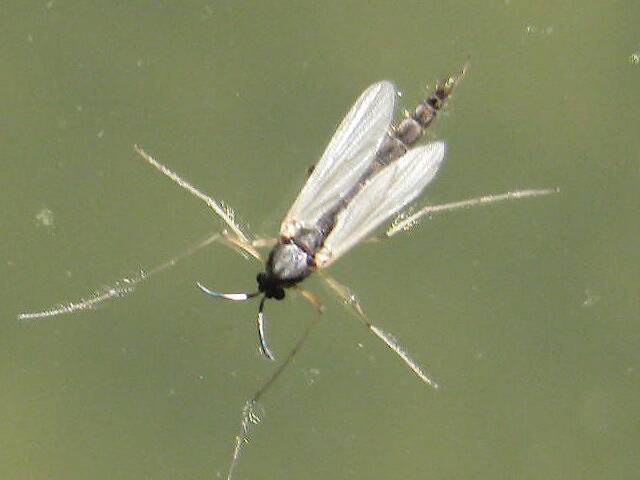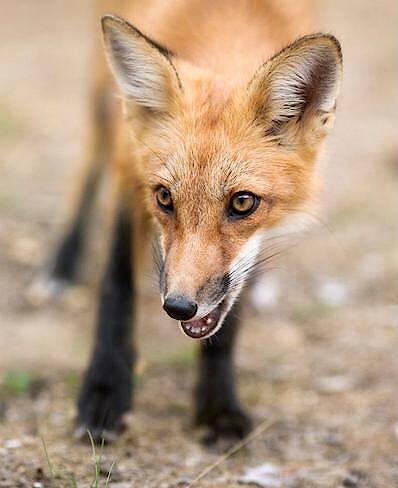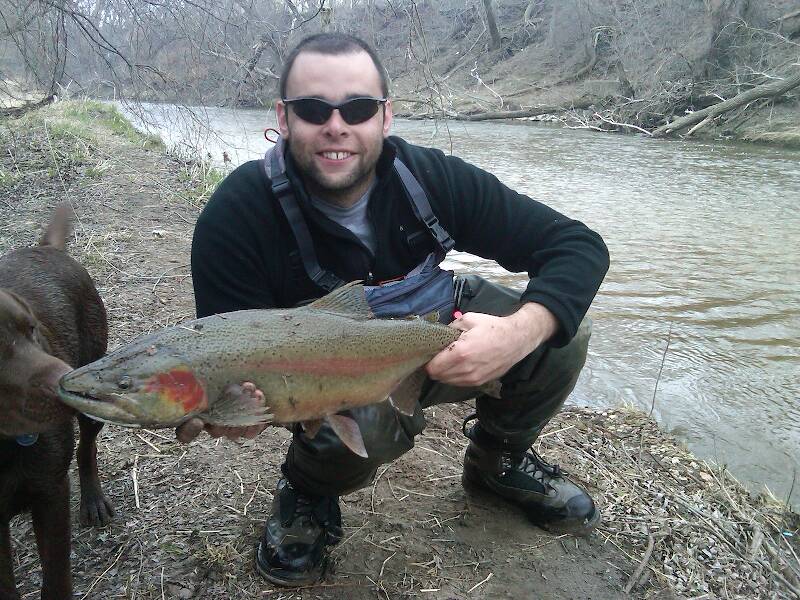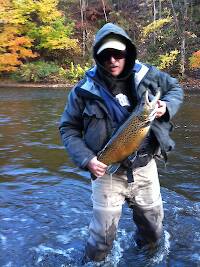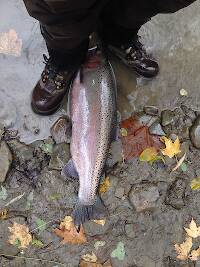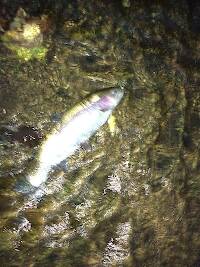
Salmonflies
Pteronarcys californica
The giant Salmonflies of the Western mountains are legendary for their proclivity to elicit consistent dry-fly action and ferocious strikes.
Featured on the forum

Nymphs of this species were fairly common in late-winter kick net samples from the upper Yakima River. Although I could not find a key to species of Zapada nymphs, a revision of the Nemouridae family by Baumann (1975) includes the following helpful sentence: "2 cervical gills on each side of midline, 1 arising inside and 1 outside of lateral cervical sclerites, usually single and elongate, sometimes constricted but with 3 or 4 branches arising beyond gill base in Zapada cinctipes." This specimen clearly has the branches and is within the range of that species.

Troutnut is a project started in 2003 by salmonid ecologist Jason "Troutnut" Neuswanger to help anglers and
fly tyers unabashedly embrace the entomological side of the sport. Learn more about Troutnut or
support the project for an enhanced experience here.
Feathers5
Posts: 287
Posts: 287
Feathers5 on Aug 25, 2014August 25th, 2014, 5:31 am EDT
You know, I ask a serious question about BWOs and I get one response. If I post an inane remark I get followers. I don't get it.
Bruce
Bruce
Falsifly on Aug 25, 2014August 25th, 2014, 12:31 pm EDT
You know, I ask a serious question about BWOs and I get one response. If I post an inane remark I get followers. I don't get it.
Bruce
Bruce, as I see it this could be the result of a number of things.
- Nobody is really serious about the BWO.
- You posted your question in General Discussion instead of Serious Discussion.
- Everyone who knows anything about the BWO is out fishing that hatch and doesn’t have time to reply.
- Most everyone is still wondering what the hell a BWO is.
- Most everyone knows what a BWO is but doesn’t know how to fish it.
- People are afraid to answer a serious question because it may appear to be a stupid answer and thus diminish their standing as being taken seriously.
- Because inane comes from the Latin word inanis how could you not expect followers?
Falsifly
When asked what I just caught that monster on I showed him. He put on his magnifiers and said, "I can't believe they can see that."
When asked what I just caught that monster on I showed him. He put on his magnifiers and said, "I can't believe they can see that."
Trout4life on Aug 25, 2014August 25th, 2014, 1:24 pm EDT
Hi Bruce, I am a new poster but have been a reader for years. What is it, that you wish to know or want to discus ??? I get to fish them here and there but I have a particular fly and Technic if you may be interested.
Kschaefer3 on Aug 25, 2014August 25th, 2014, 1:33 pm EDT
I would love to help, Bruce, but I fear I am no help at all. I know that on one of my local streams, between 5 pm and dark this time of year, I fish with a #18 comparadun bwo and catch lots of fish. I doubt that is what bug they are actually eating, but I am able to take most the risers I cast too...unless I put them down :).
Wbranch on Aug 25, 2014August 25th, 2014, 6:02 pm EDT
So what do you want to know about BWO's? I'm a fisher and not an entomologist but have been fly fishing for five decades.
Catskill fly fisher for fifty-five years.
Crepuscular on Aug 26, 2014August 26th, 2014, 4:50 am EDT
what are you whining about? You got responses and serious ones at that.
Feathers5
Posts: 287
Posts: 287
Feathers5 on Aug 26, 2014August 26th, 2014, 5:29 am EDT
what are you whining about? You got responses and serious ones at that.
What?
Jmd123 on Aug 26, 2014August 26th, 2014, 5:22 pm EDT
Bruce, don't worry, they look just like sulphurs - just tie on a #18 sulphur and you'll be just fine...
Jonathon
Jonathon
No matter how big the one you just caught is, there's always a bigger one out there somewhere...
Feathers5
Posts: 287
Posts: 287
Feathers5 on Aug 27, 2014August 27th, 2014, 5:57 am EDT
Bruce, don't worry, they look just like sulphurs - just tie on a #18 sulphur and you'll be just fine...
Jonathon
Ha! You can't go wrong with a sulphur nymph, Jonathon.
Bruce
Oldredbarn on Aug 27, 2014August 27th, 2014, 8:24 am EDT
Baetis brunneicolor...Right here from good old Troutnut...Brucie, do your homework, man! You need me to tie the darn fly on for you as well?! Eric! Take Buster fishing...He sounds like he needs it bad...Get his lucky Santa Claus hat out of storage...:) Post some pictures.
This is the largest common species of Baetis on our trout streams, and it can hatch in incredible numbers, drawing impressive rises of selective trout.
Anglers may have read in books about Baetis hiemalis, which is now a synonym of Baetis brunneicolor. It appears to have been a name for the fall-hatching brood of this species, which was reported to prefer slow water and weedy habitat instead of the gravelly riffles of the early summer brood.
Baetis brunneicolor is most often praised for the action it creates in the Midwest, but it is locally abundant in parts of the East and maybe in the West as well.
The duns drift a long distance on the water before taking flight, making them excellent dry-fly insects.
"Even when my best efforts fail it's a satisfying challenge, and that, after all, is the essence of fly fishing." -Chauncy Lively
"Envy not the man who lives beside the river, but the man the river flows through." Joseph T Heywood
"Envy not the man who lives beside the river, but the man the river flows through." Joseph T Heywood
Feathers5
Posts: 287
Posts: 287
Feathers5 on Aug 28, 2014August 28th, 2014, 4:48 am EDT
Baetis brunneicolor...Right here from good old Troutnut...Brucie, do your homework, man! You need me to tie the darn fly on for you as well?! Eric! Take Buster fishing...He sounds like he needs it bad...Get his lucky Santa Claus hat out of storage...:) Post some pictures.
This is the largest common species of Baetis on our trout streams, and it can hatch in incredible numbers, drawing impressive rises of selective trout.
Anglers may have read in books about Baetis hiemalis, which is now a synonym of Baetis brunneicolor. It appears to have been a name for the fall-hatching brood of this species, which was reported to prefer slow water and weedy habitat instead of the gravelly riffles of the early summer brood.
Baetis brunneicolor is most often praised for the action it creates in the Midwest, but it is locally abundant in parts of the East and maybe in the West as well.
The duns drift a long distance on the water before taking flight, making them excellent dry-fly insects.
Hey Spence!
I did search the site, but still couldn't decide which Baetis on which to settle my opinion.
Thanks,
Bruce
Entoman on Aug 29, 2014August 29th, 2014, 3:59 am EDT
Net some of those critters and have Eric take a look at 'em.
"It's not that I find fishing so important, it's just that I find all other endeavors of Man equally unimportant... And not nearly as much fun!" Robert Traver, Anatomy of a Fisherman
Quick Reply
Related Discussions
Topic
Replies
Last Reply
1
Apr 18, 2007
by Troutnut
by Troutnut
8
Jun 16, 2013
by PaulRoberts
by PaulRoberts
5
Dec 18, 2013
by Brookyman
by Brookyman


